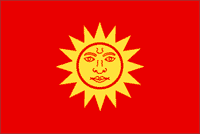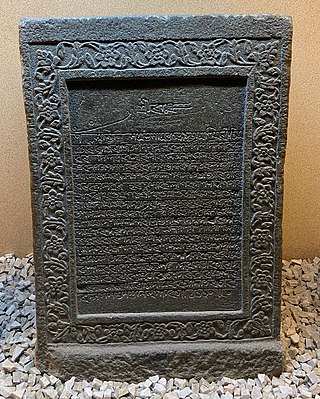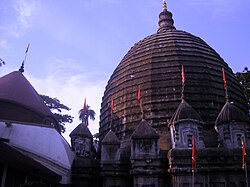
The Battle of Saraighat was a naval battle fought in 1671 between the Mughal Empire, and the Ahom Kingdom on the Brahmaputra river at Saraighat, now in Guwahati, Assam, India. The Ahoms, smarting from the occupation of the capital by Mir Jumla and the harsh conditions of Treaty of Ghilajharighat, decided to lure an Mughal imperial force to Saraighat and take a stand there. Although weaker, the Ahom Army defeated the Mughal Army by massive army, clever diplomatic negotiations to buy time, guerrilla tactics, psychological warfare, military intelligence and by exploiting the weakness of the Mughal forces—its navy.

The Dooars or Duars are the alluvial floodplains in eastern-northeastern India that lie south of the outer foothills of the Himalayas and north of the Brahmaputra River basin. This region is about 30 km (19 mi) wide and stretches over about 350 km (220 mi) from the Teesta River in West Bengal to the Dhansiri River in Assam. The region forms the gateway to Bhutan. It is part of the Terai-Duar savanna and grasslands ecoregion.

Kamarupa, an early state during the Classical period on the Indian subcontinent, was the first historical kingdom of Assam.

The history of Assam is the history of a confluence of people from the east, west, south and the north; the confluence of the Austroasiatic, Tibeto-Burman (Sino-Tibetan), Tai and Indo-Aryan cultures. Although invaded over the centuries, it was never a vassal or a colony to an external power until the third Burmese invasion in 1821, and, subsequently, the British ingress into Assam in 1824 during the First Anglo-Burmese War.

The Khen dynasty of Assam was a late medieval dynasty of erstwhile Kamata kingdom. After the fall of the Pala dynasty of Kamrupa, the western region was reorganized into Kamata kingdom, when Sandhya moved his capital from Kamarupanagara to Kamatapur in about 1257, due to the frequent clashes with the Kacharis from the east. Sandhya styled himself Kamateswara and the kingdom came to be known as "Kamata". The Khen dynasty at a later period took control of the kingdom.

The Koch dynasty ruled parts of eastern Indian subcontinent in present-day Assam and Bengal. Biswa Singha established power in the erstwhile Kamata Kingdom which had emerged from the decaying Kamarupa Kingdom. The dynasty came to power by removing the Baro-Bhuyans, who had earlier removed the short-lived rule established by Alauddin Hussain Shah.

The Kamata Kingdom emerged in western Kamarupa probably when Sandhya, a ruler of Kamarupanagara, moved his capital west to Kamatapur sometime after 1257 CE. Since it originated in the old seat of the Kamarupa kingdom, and since it covered most of the western parts of it, the kingdom is also sometimes called as Kamarupa-Kamata.

Koch Hajo (1581-1616) was the kingdom under Raghudev and his son Parikshit Narayan of the Koch dynasty that stretched from Sankosh river in the west to the Bhareli river in the east on the north bank of the Brahmaputra river. It was created by dividing the Kamata kingdom then under Nara Narayan in medieval Assam. The Sankosh river divided the two new kingdoms, and it is roughly the boundary between the present-day Assam and West Bengal. The western half of the Kamata kingdom emerged as Koch Bihar whereas the eastern half emerged as Koch Hajo. The name Hajo comes from the legendary king Hajo, a Koch tribal chief and an ancestor of the Koch dynasty, who ruled over the Rangpur division in present-day Bangladesh and some regions of present-day Assam.

Ahom–Mughal conflicts (1616–1682) refers to the series of 17th-century conflicts between the Ahoms and the Mughals over the control of the Brahmaputra valley. It began soon after the eastern branch of the Kamata kingdom then under the Koch dynasty, Koch Hajo, collapsed after a sustained Mughal campaign bringing it face-to-face with the eastern Ahoms. After nearly seventy years of sustained efforts, the Mughals were finally ousted in the Battle of Itakhuli in 1682. The Mughals since then maintained interest to the region west of the Manas river via zamindars, till they were ousted from Bengal by the British about a hundred years later.

Borphukan was one of the five patra mantris (councillors) in the Ahom kingdom, a position that was created by the Ahom king Prataap Singha. The position included both executive and judicial powers, with jurisdiction of the Ahom kingdom west of Kaliabor river. The headquarters of Borphukan was based in Kaliabor and after the Battle of Itakhuli in 1681 in Itakhuli in Guwahati. This position was particularly important and powerful because of its distance from the Ahom capital, giving it a semblance of independence. The region to the east of Kaliabor was governed by the Borbarua. Lachit Deka later became Borphukan or the ruler of Lower Assam according to the fifth chronicles of the Satsori Asom Buranji.

Biswa Singha (1515–1540) was the progenitor king of the Koch dynasty of the Kamata kingdom. He was able to unify different Bodo-Kachari tribes, replace the Baro-Bhuyans of Kamata kingdom, and establish a dynasty the remnant of which still exists today.

The Baro-Bhuyans were confederacies of soldier-landowners in Assam and Bengal in the late Middle Ages and the early modern period. The confederacies consisted of loosely independent entities, each led by a warrior chief or a landlord (zamindars). The tradition of Baro-Bhuyan is peculiar to both Assam and Bengal and differ from the tradition of Bhuihar of Uttar Pradesh and Bihar—in Assam this phenomenon came into prominence in the 13th century when they resisted the invasion of Ghiyasuddin Iwaj Shah and in Bengal when they resisted Mughal rule in the 16th century.

Kamrupi dialects are a group of regional dialects of Assamese, spoken in the Kamrup region. It formerly enjoyed prestige status. It is one of two western dialect groups of the Assamese language, the other being Goalpariya. Kamrupi is heterogeneous with three subdialects— Barpetia dialect, Nalbariya dialect and Palasbaria dialect.

Undivided Kamrup district is a former administrative district located in Western Assam from which Kamrup Rural (2003), Kamrup Metropolitan (2003), Barpeta (1983), Nalbari (1985) and Baksa (2004) districts were formed. It was announced in January 2020 that the Bajali sub-division of Barpeta district will be upgraded to a full district.

The Battle of Itakhuli was fought in 1682 between the Ahom Kingdom and the Mughal Empire. The Ahoms pushed back Mughal control to the west of the Manas river. The main battle was fought at a garrison island on the Brahmaputra, in which the Mughal fauzdar, Mansur Khan, was defeated and the remnant of the Mughal forces pursued to the Manas river. With this win, the Ahoms recovered Sarkar Kamrup from the Mughals.
Goalpara region, largely congruous to the historical undivided Goalpara district, is a region that is associated with the people and culture of Goalpara. It is bounded on the north by Bhutan, on the east by the Kamrup region, in the south by Meghalaya and in the west by Cooch Behar and Jalpaiguri in West Bengal and Rangpur in Bangladesh. The natural landmarks are: Sankosh and Brahmaputra rivers on the west, the Manas river on the east in the north bank, and a corresponding region in the south bank; the Garo Hills in the south and Bhutan Hills in the north.

The Undivided Goalpara district is an erstwhile district of Assam, India, first constituted by the British rulers of Colonial Assam.
Sandhya was a king of Kamarupa kingdom in north-eastern India in the present-day state of Assam, India. He founded the Kamata Kingdom when he moved his capital west to Kamatapur sometime after 1257 CE. He became the ruler of Kamarupa in 1228, when Sultan Nasiruddin Mahmud Shah, who had earlier killed his predecessor Raja Prithu in 1228 AD, However, after Nasir-ud-din Mahmud withdrew from Kamrup, Sandhya stopped paying tribute and assumed independence.

Balinarayan alias Dharmanarayan or Baldeo of Mughals was the son of Koch King Raghudev and younger brother of King Parikshit and the first King of Darrang Desa. He was the chief conductor of the operations conducted against the Mughals during their occupation of Kamrupa erstwhile fallen Koch Hajo which got annexed to Mughal domains after the defeat of the latter.
Momai Tamuli Borbarua (?–1650) also known by his birth name Sukuti was an able Ahom general, statesman, and noble and the first incumbent to the office of the Borbarua. He is popularly known for systemizing the paik system and for being the father of Ahom commander-in-chief Lachit Borphukan.















